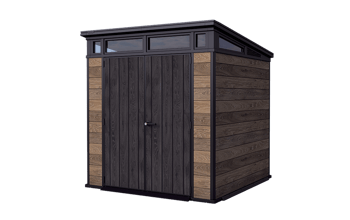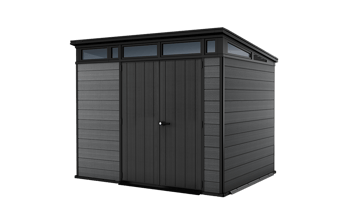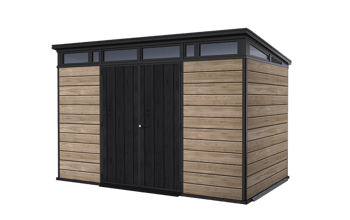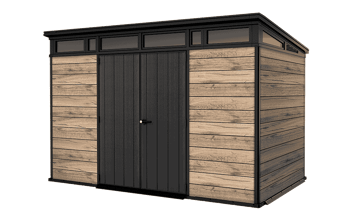
How to Dispose of an Old Shed and Get a New One
Is your backyard shed finally on the chopping block? We get it, an old shed can be quite an eyesore. However, it’s important to understand what you’re getting yourself into when it comes to getting rid of a shed. This is because the proper disposal of an old shed matters, and it can be a bit of a process. It’s important for it to be safe, do it correctly, know how to dispose of it, etc.
In this blog, we’ll talk about proper shed removal and everything to consider before taking on this project. We’ll also walk you through how to do it and what to do if you need a replacement storage shed.
Things to Consider Before Disposing of Your Shed
First things first, before you grab the crowbar and go full demo mode, take a moment to think through a few key things. Disposing of an old shed isn’t just about tearing it down. You also need to do it safely, legally and maybe even sustainably. Here’s what to keep in mind before the first nail gets pulled.
Assess the Shed’s Condition
Not every shed is destined for the dump. Take a good look—can it be repurposed for storage somewhere else? Is it solid enough to be sold or donated? You might be surprised at how many people are willing to take an old shed off your hands. This is especially true for projects like garden spaces, chicken coops or playhouses. If the structure is still sound, listing it online or offering it to a local school, farm or community group could be a good solution for you and someone else.
Check Local Regulations
Before you start demolishing your shed, check in with your city or county. Some places require a permit to demolish even small backyard structures. Others may have zoning rules or disposal restrictions. This is especially true if your shed is wired for electricity or plumbed for water. A quick call to your local building department could save you from fines. No one wants any of that.
Hazards to Look Out For
Older sheds can hide some not-so-fun surprises. So, if your shed was built decades ago, it may contain asbestos, lead paint or mold. You don’t want to mess with any of that while unprotected. Asbestos in roofing or insulation materials, flaking lead paint and damp, moldy wood are all signs you’ll want to call in a pro for proper removal. Your safety is the most important thing in this process.
How to Dispose of Shed Materials the Right Way
So you've decided the old shed has to go. That’s great! However, now comes the big question: how are you going to get rid of it? Whether you’re all about the DIY life or you’d rather pay someone to handle the heavy lifting, there’s more than one way to say goodbye to that backyard eyesore. Let’s walk through your options.

1. DIY Shed Demolition
If you're handy (or at least not afraid to get your hands dirty), tearing down a shed yourself can save money, and it’s surprisingly satisfying. However, it’s always a good idea to watch a few shed demolition videos before doing it, and be extra careful.
Tools you’ll need:
Before you start, you’ll want things like a pry bar, hammer, drill, safety goggles, gloves, a reciprocating saw and a dumpster or truck to haul away the debris.
Safety tips:
Wear heavy-duty gloves and closed-toe shoes. Always check for wasp nests, rot or electrical wiring before you start swinging. If there’s electricity or plumbing involved, turn it off at the source and consider hiring a professional.
Best way to tear it down:
Start with the roof. Remove any shingles or metal panels first, then work your way down. Walls come next, one at a time. Then unscrew or pry them loose. Leave the floor for last. This method keeps things manageable and safer as you go.
2. Hire a Professional Shed Removal Service
Sometimes it’s worth calling in the pros, especially if your shed is large, falling apart or has questionable materials like asbestos.
When it’s worth the cost:
- The shed is too dangerous to take down on your own
- You don’t have the tools or time
- You need it removed quickly and responsibly
- There is electricity and/or plumbing in your shed
Estimated pricing breakdown:
This will vary by region, and it depends on size, location and materials. It’s also worth asking when you get a quote if disposal is included. It's not the cheapest route, but it's less stressful for you and handled quickly.
3. Donate or Sell If It's Still Usable
If your shed is still in decent shape, consider giving it a second life. You’d be surprised how many DIYers are eager to haul away a used shed, especially if it’s free or cheap.
Where to list it:
Try Craigslist, Facebook Marketplace, OfferUp or even a local “buy nothing” group. Just be clear that they’ll need to handle the teardown and transport.
4. Recycling or Reusing Shed Materials
Even if your shed is beyond saving, parts of it might still be valuable.
What can be salvaged:
- Metal roofing and nails = scrap yard cash
- Untreated wood = garden beds, firewood or small builds
- Hinges, latches and hardware = perfect for DIYers
Breaking it down and sorting the materials not only keeps junk out of the landfill, but it can also save you money on disposal costs, too.
Step-by-Step DIY Shed Removal Guide

Are you ready to roll up your sleeves and get to work on that shed demolition yourself? With the right approach (and a little patience), you can absolutely knock it down safely. You might even be able to repurpose a few materials along the way. Here's a step-by-step breakdown to keep things organized and manageable from start to finish:
- Empty the Shed: Start by clearing everything out. This means tools, boxes, old lawn chairs and spiderweb-covered who-knows-whats. You want a clean and empty space before you even think about swinging a hammer. It also gives you a chance to sort what stays, what goes and what might be donated or sold.
- Turn off Utilities (if any): If your shed has power, plumbing or lighting, shut it all off at the main source before doing anything else. Cap any lines properly and consider hiring a professional to disconnect utilities if you're unsure how to do it safely. This is HUGE because you shouldn’t mess around with electricity or plumbing, especially if you have little to no experience.
- Remove Doors & Windows: Take out the doors first. Doors are bulky and can get in the way. Unscrew or pry them loose and set them aside. Then, carefully remove any windows, making sure to wear gloves and goggles. Glass shards are no fun to get stuck in your hands.
- Take off the Roof: Now it’s time to go top-down. Start by removing the shingles, panels or metal sheets, starting at the edge and working inward. Then, you’ll want to take off the rafters and beams. This part can be tricky depending on the construction. So, watch your footing and get help if you need it.
- Dismantle Walls: Start with the wall opposite any remaining structural supports. Unscrew or pry away each panel, one at a time. Be careful, though! Some walls may still be holding weight, so make sure you're not pulling down a surprise.
- Pry up the Floor: Once the walls are gone, it's time to deal with the base. Depending on your shed, you might be looking at plywood, treated wood or even a concrete slab. Pry up floorboards carefully, and be on the lookout for rusted nails or buried fasteners.
- Sort and Haul Away Materials: Don’t just dump everything into one big pile. Sort your debris. Depending on your shed type, you might see metal, untreated wood, recyclables and trash. This makes disposal easier and gives you a shot at recycling or reusing some of it. Rent a dumpster, call a junk removal service or load up your truck for a trip to the local landfill.
Whether you DIY it, donate it or hire help, the best shed removal option depends on your shed’s condition, your budget and how much effort you’re up for. Just be sure to recycle or reuse materials when you can, and don’t hesitate to call in the pros for bigger or unsafe jobs.
Safety is the number one priority when it comes to shed demolition.
And if you're planning to upgrade? Consider replacing it with a Keter shed. They come in various sizes that are all made from durable, weather-resistant resin and arrive in easy-to-assemble kits. So, they’re perfect for a fresh start!

We build in a sustainable manner.
We use innovative materials and leading technologies to build planet-friendly products that last a lifetime.















